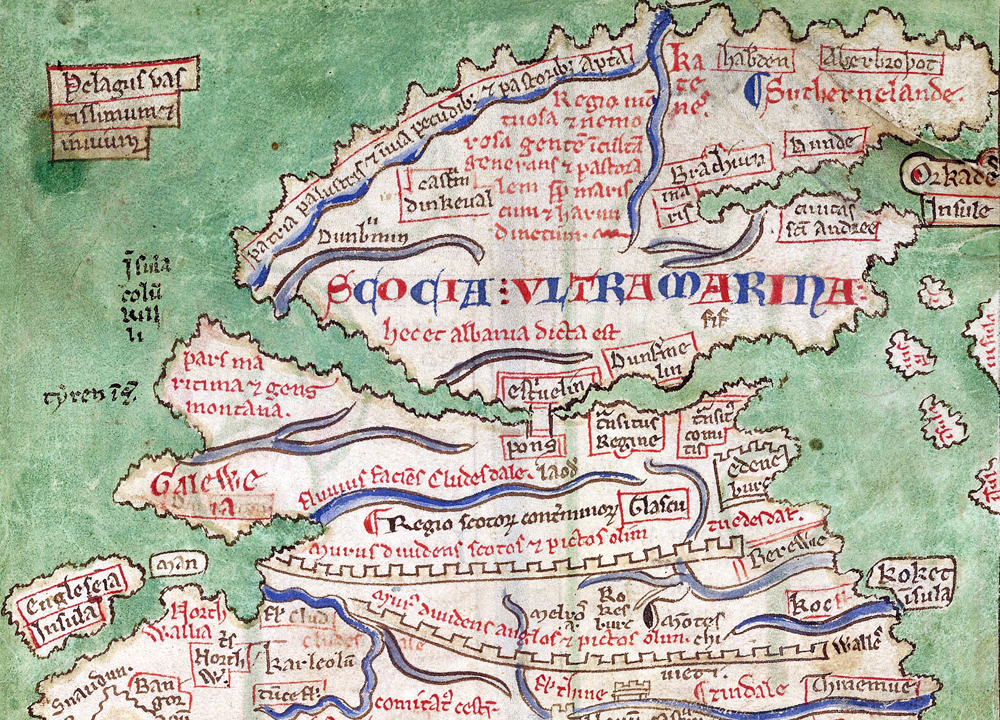The emergence of a Scottish Nation
| < Anglo-Saxons and Vikings 400 AD to 900 AD | Δ Index | The Norman Invasion 1066 > |
As Rome finally withdrew from Britain, Gaelic raiders called the Scoti began colonising Western Scotland and Wales, founding the Gaelic kingdom of Dál Riata on the west coast of Scotland in the 6th century. Irish missionaries including Saint Columba from his base in Iona in AD563, gradually converted first the Picts and then the Angles to Christianity, pulling the disparate races together.
Towards the end of the 8th century, the Viking invasions began. Looking for new territory to populate, these Norse raiders arrived in Orkney in AD800 and then quickly captured Shetland. Later, the Vikings colonised Skye and Lewis and, as their confidence grew, began to attack the mainland itself.
This forced the Picts and Gaels to cease their historic hostility to each other and to unite in the 9th century, forming the Kingdom of Scotland.
The Kingdom of Scotland was united under the House of Alpin, whose members fought among each other during frequent disputed successions.
The last Alpin king, Malcolm II, died without a male issue in the early 11th century and the kingdom passed through his daughter’s son to the House of Dunkeld or Canmore.
The last Dunkeld king, Alexander III, died in 1286. He left only his infant granddaughter Margaret, Maid of Norway as heir, who died herself four years later.
 An extract from Matthew Paris’s map of Britain from around 1250 AD map.
An extract from Matthew Paris’s map of Britain from around 1250 AD map.
The map shows the Hadrian and Antonine walls. Although Scotland is warped through 90 degrees with the Orkney and Shetlands off to the right, the map shows Galloway, Edinburgh and Berwick south of the Clyde and Forth. A road crosses Stirling Bridge into “Scocia Ultramarina” (Scotland above the sea). Dunfermline, Fife, Dundee, Saint Andrews are on the east coast. Caithness and Sutherland in the North. Dunkeld and Dunbarton to the west, with the Western Isles as one block off-shore. It is recognizably modern Scotland!
Kings of the Picts traditionally counted as King of Scots
Cináed mac Ailpín (Kenneth MacAlpin in English) defeated the rival kings, Bridei VII and Drest X winning out by around 845–848. He is traditionally considered the first “King of Scots”, or of “Picts and Scots”, although was actually ‘King of Picts’, and the terms ‘King of Alba’ and the even later ‘King of Scots’ were not used until several generations after him.
King of Picts
House of Alpin (848–1034)
| Reign | Name | Notes |
| 843 –858 | Kenneth I | son of Alpin, king of Dál Riata |
| 858 –862 | Donald I | son of Alpin and brother of Kenneth I |
| 862–877 | Constantine I | Son of Kenneth I |
| 877–878 | Áed | Son of Kenneth I |
| 878–889 | Giric | Son of Donald I? |
| 878–889 | Eochaid | grandson of Kenneth I |
King of Scots
| Reign | Name | Notes |
| 889–900 | Donald II | Son of Constantine I |
| 900–943 | Constantine II | Son of Áed |
| 943–954 | Malcolm I | Son of Donald II |
| 954–962 | Indulf | Son of Constantine II |
| 962–967 | Dub | Son of Malcolm I |
| 967–971 | Cuilén | Son of Indulf |
| 973–977 | Amlaíb | Son of Indulf |
| 971–995 | Kenneth II | Son of Malcolm I |
| 995–997 | Constantine III | Son of Cuilén |
| 997 –1005 | Kenneth III | Son of Dub |
| 1005-1034 | Malcolm II | He acquired the throne by killing Kenneth III (Cinaed III) of a rival royal dynasty. Attempted to expand his kingdom southwards with a notable victory at the Battle of Carham, Northumbria in 1018. He was driven north again in 1027 by Cnut, the Danish king of England. Malcolm died on 25th November 1034, according to one account of the time he was “killed fighting bandits”. Leaving no sons he named his grandson Duncan I, as his successor. |
House of Dunkeld (1034–1286)
| Reign | Name | Notes |
| 1034-1040 | Duncan I | Succeeded his grandfather Malcolm II as King of the Scots. Invaded northern England and besieged Durham in 1039, but was met with a disastrous defeat. Duncan was killed during, or after, a battle at Bothganowan, near Elgin, on 15th August, 1040. |
| 1040-1057 | Macbeth. | Acquired the throne after defeating Duncan I in battle following years of family feuding. He was the first Scottish king to make a pilgrimage to Rome. A generous patron of the church it is thought he was buried at Iona, the traditional resting place of the kings of the Scots. |
| < Anglo-Saxons and Vikings 400 AD to 900 AD | Δ Index | The Norman Invasion 1066 > |